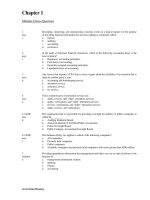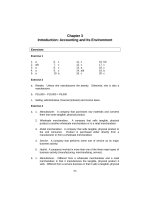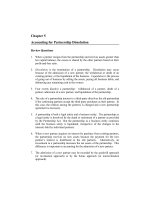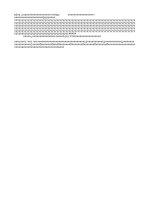Solution manual fundamentals of accounting by cabrera chapter 08 SM (incomplete)
Bạn đang xem bản rút gọn của tài liệu. Xem và tải ngay bản đầy đủ của tài liệu tại đây (71.77 KB, 8 trang )
Chapter 8
Accounting for Share Capital Transactions
Review Questions
9. Authorized share capital—the total number of shares authorized by the state
of incorporation for issuance.
Unissued share capital—the total number of shares authorized but not issued.
Issued share capital—the total number of shares issued (distributed to
shareholders).
Outstanding share capital—the total number of shares issued and still in the
hands of shareholders (issued less treasury).
Treasury shares—shares issued and repurchased by the issuing corporation
but not retired.
10. The issuance for cash of no-par value ordinary shares at a price in excess of
the stated value of the ordinary share is accounted for as follows:
1. Cash is debited for the proceeds from the issuance of the ordinary shares.
2. Ordinary share is credited for the stated value of the ordinary share.
3. Additional paid-in capital is credited for the excess of the proceeds from
the issuance of the ordinary shares over its stated value.
11. The general rule to be applied when share is issued for services or property
other than cash is that the property or services be recorded at either their fair
market value or the fair market value of the share issued, whichever is more
clearly determinable. If neither is readily determinable, the value
to be assigned is generally established by the board of directors.
12. The direct costs of issuing shares, such as underwriting costs, accounting and
legal fees, printing costs, and taxes, should be reported as a reduction of the
amounts paid in. Issue costs are there-fore debited to Additional Paid-in
Capital because they are unrelated to corporate operations.
13. The major reasons for purchasing its own shares are: (1) to provide taxefficient distributions of excess cash to shareholders, (2) to increase earnings
per share and return on equity, (3) to provide stock for employee share
compensation contracts, (4) to thwart takeover attempts or reduce the number
2
Chapter 8
of shareholders, (5) to make a market in the company’s shares, and (6) to
contract the operations of the business.
14. Additional paid-in capital results from: (1) premiums on shares issued, (2)
sale of treasury shares above cost, (3) recapitalizations or revisions in the
capital structure, (4) assessments on shareholders, (5) conversion of
convertible bonds or preference shares, and (6) declaration of a small
share dividend.
Exercises
Exercise 1
YOUNG CORPORATION
Shareholders’ Equity
December 31, 2007
Share capital - Ordinary, P5 par value
P 210,000
Paid-in capital in excess of par
1,320,000
Retained earnings
2,340,000
3,870,000
Less treasury shares
Total shareholders’ equity
(90,000)
P3,780,000
Exercise 2
Land..................................................................................
Share Capital – Ordinary (2,000 X P5)...................
Paid-in Capital in Excess of Par..............................
Exercise 3
31,000
10,000
21,000
Accounting for Share Capital Transactions
Cash (P70,000 – P1,500)....................................................
Share Capital - Ordinary..........................................
Paid-in Capital in Excess of Par..............................
3
68,500
20,000
48,500
Exercise 4
Treasury Shares.....................................................
Cash.................................................................
8,500
Cash.......................................................................
Treasury Shares...............................................
Paid-in Capital from Treasury Shares............
5,400
Cash.......................................................................
Paid-in Capital from Treasury Shares...................
Treasury Shares...............................................
3,320
80
Treasury Shares.....................................................
Cash.................................................................
15,000
Cash.......................................................................
Retained Earnings..................................................
Treasury Shares...............................................
14,000
1,000
Cash..............................................................................
Preference Shares..................................................
Paid-in Capital in Excess of Par—Preference......
61,500
7/1/07
9/1/07
11/1/07
8,500
5,100
300
3,400
Exercise 5
8/1/07
11/1/07
15,000
15,000
Exercise 6
45,000
16,500
Exercise 7
Requirement (a)
Jan. 10
Cash (80,000 X P6)
480,000
4
Chapter 8
Share Capital – Ordinary (80,000 X P5)
Paid-in Capital in Excess of Par
Mar. 1
Organization Expense
Share Capital – Ordinary (5,000 X P5)
Paid-in Capital in Excess of Par
400,000
80,000
35,000
25,000
10,000
(Note: In the past, these costs would have been charged to Organization Costs)
July
1
Sept. 1
Cash (30,000 X P8)
240,000
Share Capital – Ordinary (30,000 X P5)
Paid-in Capital in Excess of Par (30,000 X P3)
Cash (60,000 X P10)
600,000
Share Capital – Ordinary (60,000 X P5)
Paid-in Capital in Excess of Par (60,000 X P5)
150,000
90,000
300,000
300,000
Requirement (b)
Jan. 10
Mar. 1
July
1
Sept. 1
Exercise 8
Cash (80,000 X P6)
Share Capital – Ordinary (80,000 X P3)
Paid-in Capital in Excess of
Stated Value (80,000 X P3)
480,000
240,000
240,000
Organization Expense
35,000
Share Capital – Ordinary (5,000 X P3)
Paid-in Capital in Excess of
Stated Value (P35,000 – P15,000 or 5,000 X P4)
Cash (30,000 X P8)
240,000
Share Capital – Ordinary (30,000 X P3)
Paid-in Capital in Excess of
Stated Value (30,000 X P5)
Cash (60,000 X P10)
Share Capital – Ordinary (60,000 X P3)
Paid-in Capital in Excess of
Stated Value (60,000 X P7)
15,000
20,000
90,000
150,000
600,000
180,000
420,000
Accounting for Share Capital Transactions
Jan. 10
Cash (80,000 X P5)
Share Capital – Ordinary (80,000 X P1)
Paid-in Capital in Excess of Stated
Value—Ordinary Shares (80,000 X P4)
5
400,000
80,000
320,000
Mar. 1
Cash (5,000 X P108)
540,000
Share Capital – Preference (5,000 X P100)
500,000
Paid-in Capital in Excess of Par
Value—Preference Shares (5,000 X P8)
40,000
April 1
Land
80,000
Share Capital – Ordinary (24,000 X P1)
24,000
Paid-in Capital in Excess of Stated
Value—Ordinary Shares (P80,000 – P24,000)
56,000
May 1
Cash (80,000 X P7)
560,000
Share Capital – Ordinary (80,000 X P1)
80,000
Paid-in Capital in Excess of Stated
Value—Ordinary Shares (80,000 X P6)
480,000
Aug. 1
Organization Expense*
50,000
Share Capital – Ordinary (10,000 X P1)
10,000
Paid-in Capital in Excess of Stated
Value—Ordinary Shares (P50,000 – P10,000)
40,000
*(In the past, these costs would have been charged to Organization Costs)
Sept. 1
Nov. 1
Cash (10,000 X P9)
Share Capital – Ordinary (10,000 X P1)
Paid-in Capital in Excess of Stated
Value—Ordinary Shares (10,000 X P8)
Cash (1,000 X P112)
Preference Shares (1,000 X P100)
Paid-in Capital in Excess of Par
Value—Preference Shares (1,000 X P12)
90,000
10,000
80,000
112,000
100,000
12,000
6
Chapter 8
Exercise 9
Requirement (a)
Land (P62 X 25,000).......................................................... 1,550,000
Treasury Shares (P53 X 25,000).............................
1,325,000
Paid-in Capital from Treasury Shares ....................
225,000
Requirement (b)
One might use the cost of treasury shares. However, this is not a relevant measure
of this economic event. Rather, it is a measure of a prior, unrelated event. The
appraised value of the land is a reasonable alternative since the value of the asset
acquired should preferably determine the issue price of the shares. However, it is
an appraisal as opposed to a cash price. The trading price of the share is probably
the best measure of market value in this transaction.
Exercise 10
Requirement (a)
Cash [(5,000 X P45) – P7,000]..........................................
Share Capital – Ordinary (5,000 X P5)...................
218,000
25,000
Paid-in Capital in Excess of Par..............................
193,000
Requirement (b)
Land (1,000 X P46)............................................................
Share Capital – Ordinary (1,000 X P5)...................
Paid-in Capital in Excess of Par..............................
(P46,000 – P5,000)
46,000
5,000
41,000
Note: The market value of the share (P46,000) is used to value the
exchange because it is a more objective measure than the appraised value
of the land (P50,000).
Requirement (c)
Accounting for Share Capital Transactions
Treasury Shares (500 X P43).............................................
Cash..........................................................................
7
21,500
21,500
Exercise 11
May 2
May 10
15
Exercise 12
Cash
Share Capital – Ordinary (12,000 X P5)
Paid-in Capital in Excess of Par—
Ordinary Shares (12,000 X P11)
192,000
Cash
Preference Shares (10,000 X P30)
Paid-in Capital in Excess of Par—
Preference Shares (10,000 X P30)
600,000
Treasury Shares*
Cash
60,000
132,000
300,000
300,000
15,000
15,000
8
Chapter 8
a. Feb. 10 Treasury Shares...................................................................
435,000
Cash........................................................................ 435,000
Purchased 14,500 treasury shares at P30 per
share.
June 4 Cash.....................................................................................
198,000
Treasury Shares...................................................... 180,000
Additional Paid-in Capital: Treasury
Share Transactions................................................
18,000
Sold 6,000 treasury shares, cost P180,000, for
P33 per share.
Dec. 22 Cash.....................................................................................
112,000
Additional Paid-in Capital: Treasury Share
Transactions......................................................................
8,000
Treasury Shares...................................................... 120,000
Sold 4,000 treasury shares, cost P120,000, for
P28 per share.
b. Restriction of retained earnings for treasury shares owned at year-end:
P135,000 (4,500 shares still owned × P30 per share cost)
c. No, a restriction on retained earnings does not affect the total amount of
retained earnings reported in the balance sheet. A restriction of retained
earnings is disclosed, but does not reduce the total amount of retained
earnings of a company. The restriction on retained earnings simply limits the
amount of dividends the corporation can pay as long as it holds treasury
shares.









